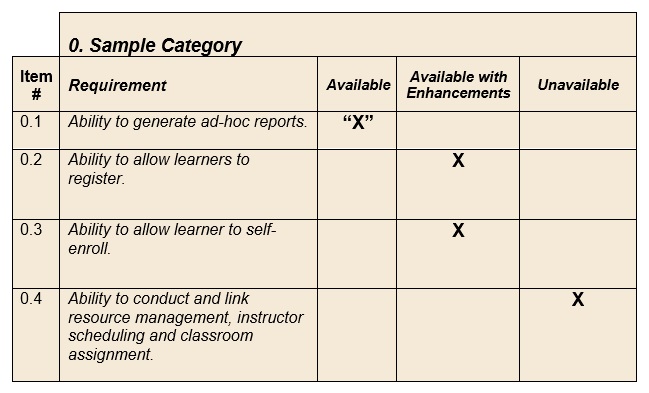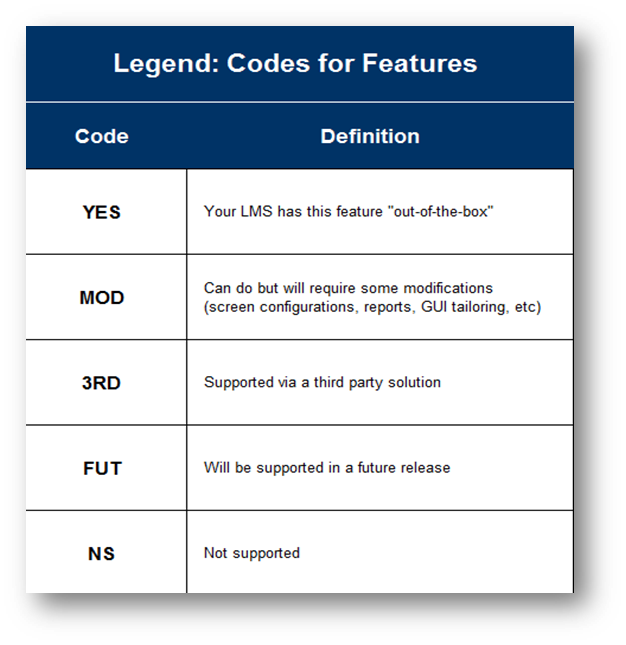Getting the Most Out of BaseCorp’s RFI and RFP Templates
Sarah Flesher
Our eBook Creating an Effective RFP for Your LMS Project included links to our fully-customizable RFI and RFP templates. Here, I'll go into more detail regarding these documents, and how they can help you create a powerful RFP.
The Secret to a Successful RFP
The best way to ensure a successful LMS selection is to follow the KISS principle when undertaking an RFP: you want to Keep It Simple. Obviously, you want to ensure you get all the information you need, but sometimes the best way to ensure this happens is to supply potential vendors with a basic RFP in order to narrow the field, and then focus on live demos and presentations. Not only does this step allow you to get a better idea of whether a potential vendor is someone you want to do business with, it also allows you to actually get your hands dirty and explore an LMS on your own terms. Does your potential vendor offer a free trial? Even better! Now you can see just how easy (or not) the admin side is, and whether the LMS can deliver what you need it to.
That being said, the RFI and RFP still play a key role in the selection process. The LMS market is huge, and you need to have some way to narrow the field to certain key vendors. But, with live demos being where the real value is, do you really want to waste your limited time comparing 40+ page RFPs? We've been on the receiving end of some of these documents, and now it's our mission to show you that there is a better way!
The RFI Template
You may or may not want to complete an RFI, or request for information. While not always necessary, it can be a valuable tool when:
- You want a fast and effective way to gather information
- You want a better idea of the full range of offerings from a variety of vendors
Download our customizable RFI Template and adjust it as necessary; we've included sections where you can describe the background information of your organization, as well what information you are seeking. We have also given you some sample response guidelines as well as a note regarding demonstrations. If you would like more information, add that in. Less? Take anything extraneous out! This is your RFI, and you want to make sure it's giving you what you want.
The last section of this template, Desired Functionality, is where it really shines. We have built a listing of LMS capabilities, and broken them out into different sections. Again, customize this to suit your specific requirements, but we have made it as easy as possible not only for your vendors to give you a quick overview of what they can provide, but for you to compare various LMSs against each other.
Here's a sample of what we have built:

The RFP Template
Here's where the rubber meets the road; we have provided two RFP, or request for proposal, templates, a Word and an Excel version, and we recommend you use these in conjunction with each other. As Sarah discusses in Creating an Effective RFP for Your LMS Project, a typical RFP will include seven sections:
- Table of contents
- Background/company information
- Business case summary
- Requirements list
- Proposed time frame
- Special terms
- Submission instructions
Again, and we can't stress this enough - your RFP does not have to include all these sections! There are no hard and fast rules for your RFP - feel free to tinker with this list until it's what you want. Our downloadable Word template has laid out these basic sections, along with some tips for when you are filling in your information.
The Excel template is a beefed-up version of the functionality list that we included in the RFI Template. We have provided additional options for vendors to talk about the capabilities of their LMS, as shown in the table below:

On the 'Features list' tab, vendors are asked to note whether their LMS is local or hosted, meaning if it will be housed on your server or in the Cloud. Then simply fill out your requirements (to make it even easier to review, we have separated these into must have, highly desired, and nice to have sections), and let your vendor use the legend to do the rest.
The RFP Excel Template also has an RFP Price tab. We recommend allowing vendors to submit a separate quote as an attachment only if they have also filled out the information required on the template. Asking for a per unit cost for price, implementation or set up, training, support and other considerations will allow you to compare all potential vendors on a level playing field, without expending a lot of time or effort.
The RFP Information and Sample Features List
Finally, this tool provides a comprehensive overview of the areas of inquiry you may want to incorporate in your dialogue with potential vendors. While we don't recommend including everything you see in this document into your RFP, it does act as a guide if you feel like you would like to expand on our provided RFP template.
Conclusion
So, we realise that it may seem a little strange to create all these resources just to convince you to do less work, but, at BaseCorp, we are passionate about optimization. RFPs are a very important part of the LMS selection process, but there's no reason they need to be the all-encompassing documents we have seen in the past. Remember, as a client, you will see the most value when you can actually view the LMS in action. Use the RFP to get you to that stage with the right vendors; don't waste precious time and resources when you don't have to. Still have questions? Contact us, we're always happy to help!
Download our eBook to start drafting your own succinct, well-written RFP today!
Free eBook
Creating an Effective RFP for Your LMS Project
Learn how to optimize the RFP process and choose the best LMS for your needs!
📘 Ready to Elevate Your Learning Strategy?
Explore our comprehensive library of eBooks and tools on learning resource development, competency-based learning, and LMS implementation. Transform your training programs with insights from industry experts and practical templates.
Sarah Flesher
Sarah is an Instructional Designer at BaseCorp Learning Systems and is currently completing a PhD in Educational Technology. Her research focuses on implementing competency-based learning systems in all types of organizations. When she doesn't have her nose in a book you can find her at the gym, on the ice, on the ski hill, drinking wine or in a coffee shop … with her nose in a book.

